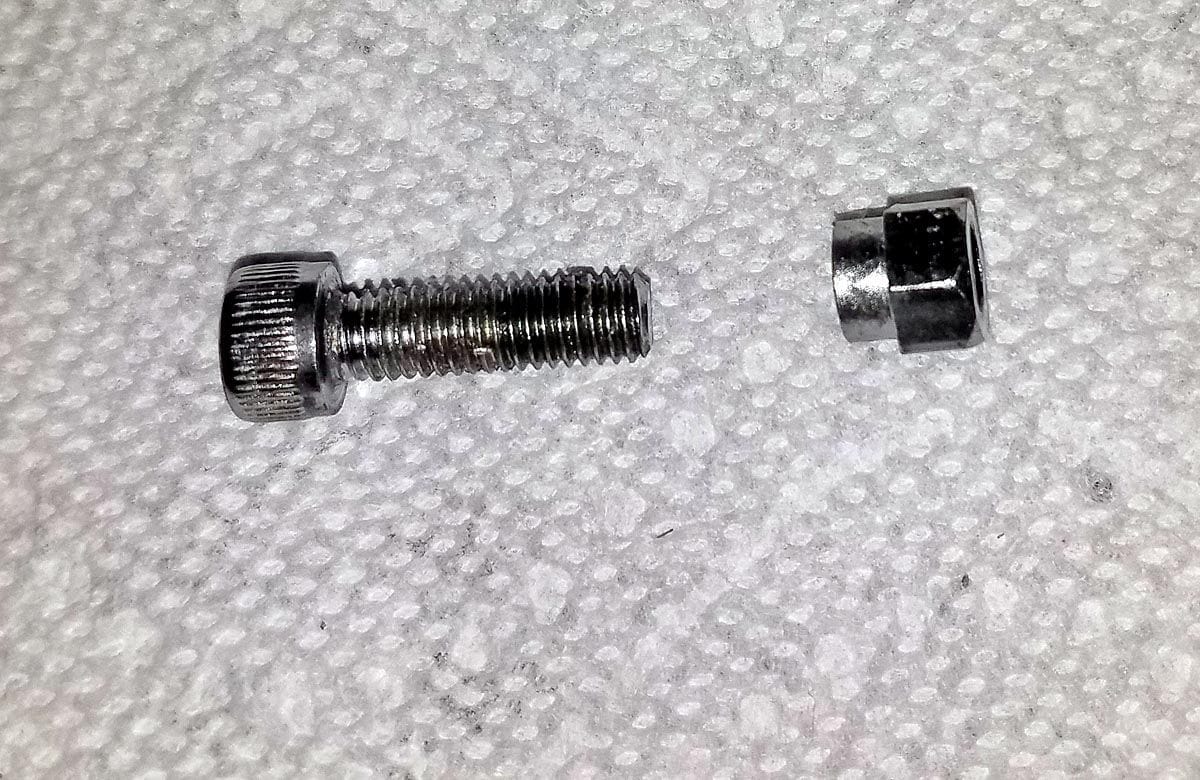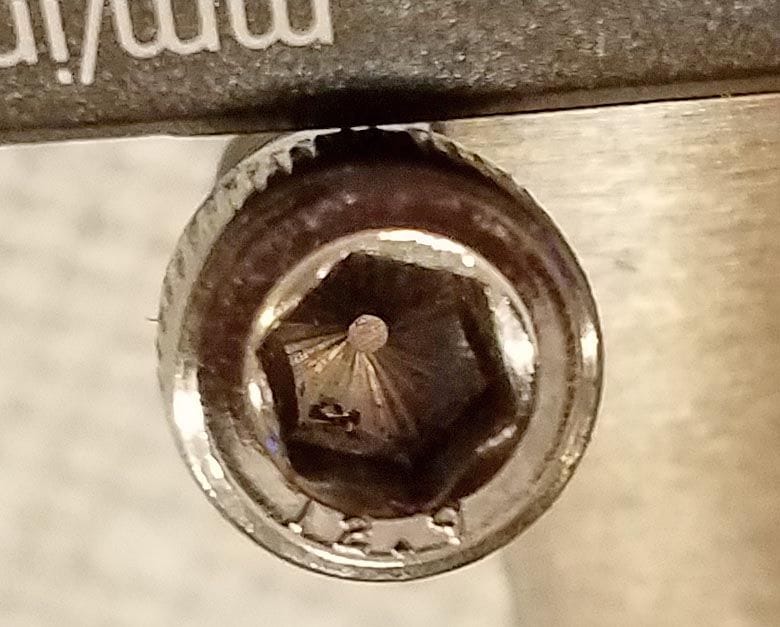'85 Fuji Opus III Seatpost Questions
#1
Fillet-Brazed Member
Thread Starter
'85 Fuji Opus III Seatpost Questions
Can anyone recommend a binder bolt for this frame? I'm not familiar with the style.
I'd also like to know the proper seatpost diameter. Fuji tubing decal on seat tube says 9658. 26.6 seemed to fit well though I think I've read it may be 26.8 ...
Thanks


I'd also like to know the proper seatpost diameter. Fuji tubing decal on seat tube says 9658. 26.6 seemed to fit well though I think I've read it may be 26.8 ...
Thanks


#2
Senior Member
Join Date: Aug 2010
Location: Utah
Posts: 8,667
Bikes: Paletti,Pinarello Monviso,Duell Vienna,Giordana XL Super,Lemond Maillot Juane.& custom,PDG Paramount,Fuji Opus III,Davidson Impulse,Pashley Guv'nor,Evans,Fishlips,Y-Foil,Softride, Tetra Pro, CAAD8 Optimo,
Mentioned: 156 Post(s)
Tagged: 0 Thread(s)
Quoted: 2323 Post(s)
Liked 4,981 Times
in
1,775 Posts
Ok, I had more time tonight. So I pulled the seatpost and measured again several times with the digital calipers. I keep getting 26.78. Not sure why I was getting larger yesterday, sorry.
I also pulled the binder bolt. I'm getting around 25.6mm overall length including the head. The threaded section is 19mm for the treaded section and about 6mm for the head which is right under 10mm wide. Sorry but I don't have any way to measure the thread pitch. I'm getting around 5.7mm for the width of the threaded section. The top of the bolt is stamped with 12. 9. The nut has a collar section on it too. I'm getting right under 9mm for the width. It.s 8.5mm long. The collar part of the nut is 7.77 mm wide. No markings on the nut itself. I'll put some pics up in a couple of minutes.
I also pulled the binder bolt. I'm getting around 25.6mm overall length including the head. The threaded section is 19mm for the treaded section and about 6mm for the head which is right under 10mm wide. Sorry but I don't have any way to measure the thread pitch. I'm getting around 5.7mm for the width of the threaded section. The top of the bolt is stamped with 12. 9. The nut has a collar section on it too. I'm getting right under 9mm for the width. It.s 8.5mm long. The collar part of the nut is 7.77 mm wide. No markings on the nut itself. I'll put some pics up in a couple of minutes.
__________________
Steel is real...and comfy.
Steel is real...and comfy.
#3
Senior Member
Join Date: Aug 2010
Location: Utah
Posts: 8,667
Bikes: Paletti,Pinarello Monviso,Duell Vienna,Giordana XL Super,Lemond Maillot Juane.& custom,PDG Paramount,Fuji Opus III,Davidson Impulse,Pashley Guv'nor,Evans,Fishlips,Y-Foil,Softride, Tetra Pro, CAAD8 Optimo,
Mentioned: 156 Post(s)
Tagged: 0 Thread(s)
Quoted: 2323 Post(s)
Liked 4,981 Times
in
1,775 Posts
Ok, some pics with a cell phone. Not the best quality but didn't want to break out the macro gear.
Oh and the recessed head bolt takes a 5mm allen wrench.


Ok and I kept looking and looking at the seatpost. Finally held it just right in the light and it is stamped with a 26.8. This is the original seatpost so that should answer that question for sure.
Oh and the recessed head bolt takes a 5mm allen wrench.


Ok and I kept looking and looking at the seatpost. Finally held it just right in the light and it is stamped with a 26.8. This is the original seatpost so that should answer that question for sure.
__________________
Steel is real...and comfy.
Steel is real...and comfy.
#5
Thrifty Bill
Join Date: Jan 2008
Location: Mountains of Western NC
Posts: 23,524
Bikes: 86 Katakura Silk, 87 Prologue X2, 88 Cimarron LE, 1975 Sekai 4000 Professional, 73 Paramount, plus more
Mentioned: 96 Post(s)
Tagged: 0 Thread(s)
Quoted: 1236 Post(s)
Liked 964 Times
in
628 Posts
Iíve used a stainless bolt the right size and a nut. I had to grind down the nut a little to fit, as the outside dimensions of the regular nut are too large.
#6
Senior Member
Join Date: Nov 2004
Posts: 23,223
Mentioned: 654 Post(s)
Tagged: 1 Thread(s)
Quoted: 4722 Post(s)
Likes: 0
Liked 3,036 Times
in
1,874 Posts
Regarding the proper seat post size, it can be calculated. Fuji 9658 is a quadruple butted tubing and the four numerals in the tubing designation indicate the wall thickness (ie. 0.9mm, 0.6mm, 0.5mm & 0.8mm). The bottom end of the seat tube is the thick butt (i.e. 0.9mm) while the top butt is 0,8mm. Given that the nominal outside diameter of an imperial seat tube 28.6mm, the nominal inside diameter for 0.8mm wall thickness would be 27.0mm. Allowing for the standard 0.2mm diametrical clearance would result in a 26.8mm seat post. This is corroborated by the size stamped on jamesdak's post.
BTW, Fuji typically sourced their tubeset from Ishiwata. Fuji 9658 corresponds to Ishiwata EXO-M.
BTW, Fuji typically sourced their tubeset from Ishiwata. Fuji 9658 corresponds to Ishiwata EXO-M.
#8
Fillet-Brazed Member
Thread Starter
#9
Fillet-Brazed Member
Thread Starter
Regarding the proper seat post size, it can be calculated. Fuji 9658 is a quadruple butted tubing and the four numerals in the tubing designation indicate the wall thickness (ie. 0.9mm, 0.6mm, 0.5mm & 0.8mm). The bottom end of the seat tube is the thick butt (i.e. 0.9mm) while the top butt is 0,8mm. Given that the nominal outside diameter of an imperial seat tube 28.6mm, the nominal inside diameter for 0.8mm wall thickness would be 27.0mm. Allowing for the standard 0.2mm diametrical clearance would result in a 26.8mm seat post. This is corroborated by the size stamped on jamesdak's post.
BTW, Fuji typically sourced their tubeset from Ishiwata. Fuji 9658 corresponds to Ishiwata EXO-M.
BTW, Fuji typically sourced their tubeset from Ishiwata. Fuji 9658 corresponds to Ishiwata EXO-M.
I get the 9-6-5-8 butt dimensions with 0.8mm corresponding to the top butt ... can you detail the math of how you arrived at 26.8mm?
Also interesting that EXO-M is seamed according to an earlier thread ... does this affect the ride? I was told this is a very nice riding frame, but would think seamed tubing is lower end to seamless, perhaps not necessarily?
Last edited by specialmonkey; 02-26-19 at 11:36 AM.
#10
Senior Member
Join Date: Nov 2004
Posts: 23,223
Mentioned: 654 Post(s)
Tagged: 1 Thread(s)
Quoted: 4722 Post(s)
Likes: 0
Liked 3,036 Times
in
1,874 Posts
Well, you need some allowance for clearance after accounting for the tolerance limits on both the seat post and seat tube. While items are designed to a specific (i.e nominal) dimension , there will be slight variations above and below that dimension due to the capability of the manufacturing process. So, if both the post and seat tube were designed for the same nominal dimension, there would be numerous cases where the post was oversize and the tube was undersize, resulting in an interference fit. Based on manufacturing tolerances, a 0.2mm difference in nominal diameter, gives good product yield (i.e. a low level of defects) while assuring a clearance fit. Also, remember that 0.2mm is the diametrical clearance, making the radial clearance only 0.1mm.
if you compare the nominal inner diameter of seat tubes with the corresponding diameter of their matching seat posts, you'll find that a 0.2mm is the most common difference, making it the defacto standard. For instance, the nominal inner diameter of the ubiquitous Columbus SL/SLX seat tube is 27.4mm and manufacturers routinely spec a 27.2mm post with it.
#11
Senior Member
Join Date: Nov 2004
Posts: 23,223
Mentioned: 654 Post(s)
Tagged: 1 Thread(s)
Quoted: 4722 Post(s)
Likes: 0
Liked 3,036 Times
in
1,874 Posts
nominal tubing thickness = 0.8mm
nominal seat tube inner diameter = nominal seat tube outer diameter - 2(wall thickness)
= 28.6 - 2(0.8)
= 28.6 -1.6
=27.0
Allow another 0.2mm for clearance and the seat post size is 26.8mm
#12
Senior Member
Join Date: Nov 2004
Posts: 23,223
Mentioned: 654 Post(s)
Tagged: 1 Thread(s)
Quoted: 4722 Post(s)
Likes: 0
Liked 3,036 Times
in
1,874 Posts
...Also interesting that EXO-M is seamed according to an earlier thread ... does this affect the ride? I was told this is a very nice riding frame, but would think seamed tubing is lower end to seamless, perhaps not necessarily?
Seamed tubing involves taking a flat sheet of steel and rolling it into a tube and welding a longitudinal seam. During the 1970s bicycle boom and earlier, welded tubing had a poor reputation for durability with reported seam failures. As such, it was used on very low grade frames, while high grade frames used seamless tubing. However, by the early 1980s welding technology had developed to the point where seamed tubing was no longer a reliability concern. It was much less expensive to manufacture butted tubing by forming the butts on flat sheet then rolling them into tubes and welding them. This drastically reduced the cost of butted tubing in the early 1980s and helped bring butted tubesets with their lower weight and more resilient ride, down to the mid-range price level. Still, some cyclists had a stigma about seamed tubing and seamless tubesets continued to be offered as an alternative. Seamed tubing has no noticeable effect on ride characteristics and I have yet to see a seam failure on a 1980+ seamed tubeset.
#13
Fillet-Brazed Member
Thread Starter
nominal seat tube outer diameter = 28.6mm. This is standard for a imperial seat tube of this era.
nominal tubing thickness = 0.8mm
nominal seat tube inner diameter = nominal seat tube outer diameter - 2(wall thickness)
= 28.6 - 2(0.8)
= 28.6 -1.6
=27.0
Allow another 0.2mm for clearance and the seat post size is 26.8mm
nominal tubing thickness = 0.8mm
nominal seat tube inner diameter = nominal seat tube outer diameter - 2(wall thickness)
= 28.6 - 2(0.8)
= 28.6 -1.6
=27.0
Allow another 0.2mm for clearance and the seat post size is 26.8mm
#14
Fillet-Brazed Member
Thread Starter
Seamed tubing involves taking a flat sheet of steel and rolling it into a tube and welding a longitudinal seam. During the 1970s bicycle boom and earlier, welded tubing had a poor reputation for durability with reported seam failures. As such, it was used on very low grade frames, while high grade frames used seamless tubing. However, by the early 1980s welding technology had developed to the point where seamed tubing was no longer a reliability concern. It was much less expensive to manufacture butted tubing by forming the butts on flat sheet then rolling them into tubes and welding them. This drastically reduced the cost of butted tubing in the early 1980s and helped bring butted tubesets with their lower weight and more resilient ride, down to the mid-range price level. Still, some cyclists had a stigma about seamed tubing and seamless tubesets continued to be offered as an alternative. Seamed tubing has no noticeable effect on ride characteristics and I have yet to see a seam failure on a 1980+ seamed tubeset.
#15
Senior Member
Join Date: Nov 2004
Posts: 23,223
Mentioned: 654 Post(s)
Tagged: 1 Thread(s)
Quoted: 4722 Post(s)
Likes: 0
Liked 3,036 Times
in
1,874 Posts
Since we're talking in terms of diameter, you have to subtract the tubing wall thickness from the two, diametrically opposed, sides of the tube.









